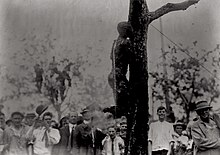
Back إعدام جيسي واشنطن Arabic Linxament de Jesse Washington Catalan Linchamiento de Jesse Washington Spanish لینچکردن جسی واشینگتن Persian Jesse Washingtonin lynkkaus Finnish Lynchage de Jesse Washington French הלינץ' בג'סי וושינגטון HE Penghakiman massa Jesse Washington ID Linciaggio di Jesse Washington Italian ジェシー・ワシントンリンチ事件 Japanese
| Lynching of Jesse Washington | |
|---|---|
 Large crowd looking at the burned body of Washington | |
| Location | Waco, Texas |
| Coordinates | 31°33′30″N 97°07′47″W / 31.55833°N 97.12972°W |
| Date | May 15, 1916 |
| Part of a series on the |
| Nadir of American race relations |
|---|
 |
Jesse Washington was a seventeen-year-old African American farmhand who was lynched in the county seat of Waco, Texas, on May 15, 1916, in what became a well-known example of lynching. Washington was convicted of raping and murdering Lucy Fryer, the wife of his white employer in rural Robinson, Texas. He was chained by his neck and dragged out of the county court by observers. He was then paraded through the street, all while being stabbed and beaten, before being held down and castrated. He was then lynched in front of Waco's city hall.
Over 10,000 spectators, including city officials and police, gathered to watch the attack. There was a celebratory atmosphere among whites at the spectacle of the murder, and many children attended during their lunch hour. Members of the mob cut off his fingers and hung him over a bonfire after saturating him with coal oil. He was repeatedly lowered and raised over the fire for about two hours. After the fire was extinguished, his charred torso was dragged through the town. A professional photographer took pictures as the event unfolded, providing rare imagery of a lynching in progress. The pictures were printed and sold as postcards in Waco.
Although the lynching was supported by many Waco residents, it was condemned by newspapers around the United States. The National Association for the Advancement of Colored People (NAACP) hired Elisabeth Freeman to investigate; she conducted a detailed probe in Waco, despite the reluctance of many residents to speak about the event. Freeman concluded that white residents were generally supportive of Washington's lynching. She also concluded that Washington killed Fryer. After receiving Freeman's report on the lynching, NAACP co-founder and editor W. E. B. Du Bois published an in-depth report featuring photographs of Washington's charred body in The Crisis, and the NAACP featured his death in their anti-lynching campaign.
Historians have noted that Washington's death helped alter the way lynching was viewed. The widespread negative publicity helped curb public support for the practice. In the 1990s and 2000s, some Waco residents lobbied for a monument to Washington's lynching, but this idea failed to garner wide support in the city. On the centennial of the event in May 2016, the mayor of Waco held a formal ceremony to apologize to Washington's relatives and the African American community. A historical marker has been installed to memorialize the lynching.
© MMXXIII Rich X Search. We shall prevail. All rights reserved. Rich X Search